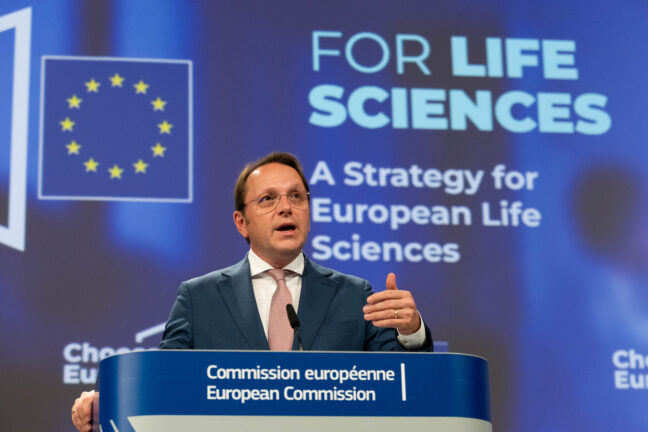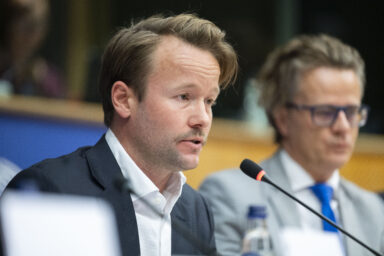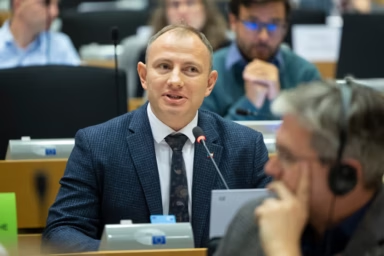On 2 July, the European Commission unveiled its Life Sciences Strategy. The three-phase plan aims to make Europe the world’s most attractive destination for life sciences innovation by 2030.
The Commission calls the blueprint a ‘clear European offer’ to ensure that breakthrough science is discovered, developed, and deployed in Europe.
“We have no time to lose,” Health Commissioner Olivér Várhelyi said at a press conference. “What you see today and what you’re going to read is a very clear roadmap. A European offer on how to make Europe the global leader in life sciences by 2030.”
His blueprint landed just days after the European Federation of Pharmaceutical Industries and Associations (EFPIA) sounded its own alarm.
You might be interested
“This is a now-or-never kind of moment,” said EFPIA Director-General Nathalie Moll, at their press conference about the opportunity for Europe to reset and to lead in global life sciences.
“You need the research and innovation to be looked after. You need the regulation to be fantastic. And then you need a market that actually pulls products through.”
This is a now-or-never kind of moment. – Nathalie Moll, Director-General, European Federation of Pharmaceutical Industries (EFPIA)
New EFPIA President Stefan Oelrich framed the challenge in even starker terms:
“Our vision is to reinstate Europe as a global innovation epicentre where the biopharmaceutical industry not only survives but thrives. To do this, we need to press the reset button on three strategic pillars. Attract investment, accelerate science, and ensure access for patients.”
Reset button
That reset is precisely what the Commission now promises. The strategy covers the full value chain and aligns with existing EU initiatives like the start-up and scale-up strategy, the Savings & Investments Union, and the Union of Skills. Forthcoming files include a dedicated EU Biotech Act, a medical countermeasures strategy, a stockpiling plan and an updated bioeconomy strategy.
Internally, the Commission will create a Life Sciences Coordination Group to align regulation, funding and foresight activities across services and sectors.
The EU supports this ambition with over €10 billion annually through 2027, drawn from major programmes including Horizon Europe and EU4Health.
Optimising the research and innovation ecosystem
The strategy’s first phase tackles Europe’s long-standing weakness: converting excellent science into market-ready therapies. Targeted investment will flow into clinical trials, cross-sector innovation, AI-enabled research, and advanced manufacturing.
New Centres of Excellence for cell and gene therapies aim to keep development in Europe. While dedicated funding will support microbiome research, biomanufacturing, and digital infrastructure.
“In Europe we’re now below 20 percent of global clinical trials, that is simply not sustainable,” Várhelyi said. “We have to act, starting with centres of excellence for advanced therapies. So we don’t lose these innovations to other parts of the world.”
Europe will better leverage its data assets through a new Research & Innovation Data Assembly and €75 million invested in AI-powered infrastructure. “We will fully use the possibilities that the European Health Data Space will offer,” Várhelyi said. “Not only for the benefit of the citizens. But also to make sure that the scientists, the innovators, and the investors will have access to that data as well.”
The talent agenda is equally forward-looking. “We want to make sure the right skills are available. Not just today, but tomorrow,” Várhelyi said. He referred to a skills foresight study and the EU’s ‘Choose Europe’ campaign to attract global researchers to EU labs.
In Europe we’re now below 20 percent of global clinical trials, that is simply not sustainable. – Olivér Várhelyi, Health Commissioner
Untapped potential
EFPIA President Stefan Oelrich sees untapped potential. “We don’t have to hide in terms of our ability to innovate. We’re finding cell and gene therapies, druggable targets… There’s tremendous innovation happening,” he said.
But without stronger capital markets, those breakthroughs risk leaving Europe. “Translation follows where the capital is,” he added, calling for NASDAQ-style support for biotech scale-up. “It’s not for lack of capital in Europe, it’s how we deploy it.”
He also urged stronger public-private partnerships and deeper ties between academia and industry. “Europe has a 150-year history in excellence in chemistry. This is our ground,” he said. “We are the natural outlet to actually scale innovation… But we need to enable ourselves.”
Providing smooth and rapid market access
The second phase zeroes in on Europe’s fragmented and slow-moving regulatory landscape. A new EU Biotech Act, expected at the end of 2025, will align biotech regulation across Member States and sectors.
Complementary reforms include regulatory sandboxes for testing breakthrough technologies, decentralised trial models scaled from the COVID-19 response, and an AI-powered navigation tool to help innovators work through EU law.
“We are working on regulatory sandboxes. On how to approve new therapies faster. And make sure innovation actually reaches the patient,” Várhelyi said.
An EU investment plan under Horizon Europe will expand cross-border trial infrastructure to accelerate access across Member States.
Boosting uptake and trust in innovation
In the third phase, Várhelyi focuses on the ‘last mile,’ working to ensure that innovation earns trust and is widely adopted. A €300 million fund will support public procurement of high-impact health solutions such as vaccines and cancer treatments. A strategic matchmaking interface will link start-ups with industry and investors.
To boost public confidence, €2 million will fund risk and science communication tools, pilot outreach measures, and co-creation with patients and clinicians. “Even the best innovations won’t succeed without trust,” the strategy notes.
The Life Sciences Coordination Group will anchor governance by aligning policy, funding, and regulation. It will also oversee the EU R&I Data Assembly, guide use of the AI-powered regulatory assistant, convene high-level dialogues and stakeholder forums, and scan for breakthrough technologies to shape future priorities.
In a reaction to the EU Life Sciences Strategy Moll said in a statement: “That EU policy makers recognise the need to reverse declining trends and actively seek new investments is extremely encouraging. The sector in Europe has been on the ropes for two decades and the Strategy delivers some good news at a time when it is most needed. For Europe to truly lead it needs to invest in medicines, attract investment, accelerate turning that investment into new treatments and economic growth as well as ensuring that patients across the EU get access to them at the same pace as other regions.”
What happens next, and fast
Commissioner Várhelyi shared a tight timeline for 2025:
“For the rest of this year, the most important elements we’ll bring forward are, first, a full review of the medical-devices rules; second, a Biotech Act that will also revise the clinical-trials regulation; and third, a comprehensive European Cardiovascular Health Plan. We want all of this on the table before year-end, we have no time to lose.”











